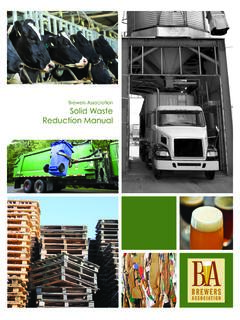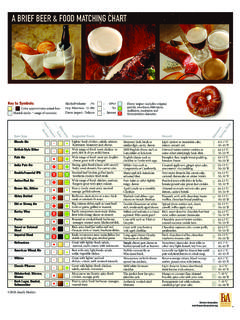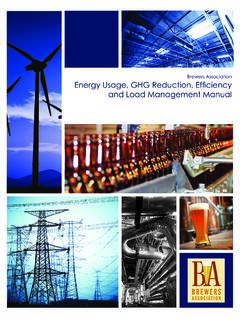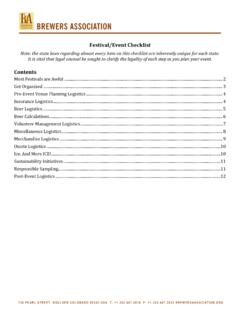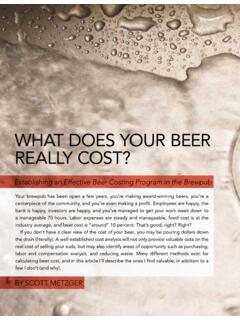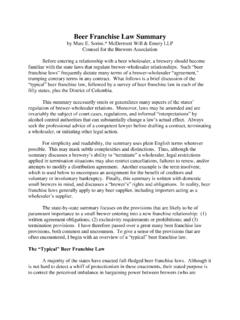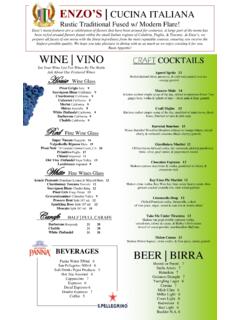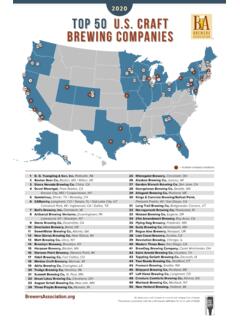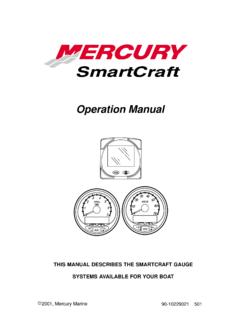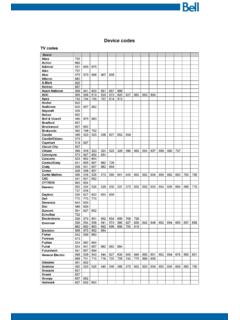Transcription of Brewers Association Wastewater Management Guidance …
1 1 Wastewater Management Guidance ManualWater and WastewaterBrewers AssociationWastewater Management Guidance Manual ..3introduction ..4section one .. Background .. Benchmarking Results .. Example Calculations ..8section two .. Background .. General Municipal Ordinance Limitations .. Industrial User .. Significant Industrial User .. Total Maximum Daily Loads ..12section three .. Background .. Sampling and Analysis .. Negotiation Strategies ..15section four .. Background .. Incoming water and outgoing Wastewater .. Inventory of Drains .. Sampling and Analysis ..19section five .. Background .. Best Practices .. Sanitary vs. process Wastewater .. Solids removal .. Side streaming options ..22section six .. Reduce .. Reuse .. Recycle ..25section seven .. Introduction .. Less than or equal to 1,000 bbls per year .. 1,000 10,000 bbls per year .. 10,000 100,000 bbls per year .. Greater than or equal to 100,000 bbls per year.
2 27section eight ..28references ..30selected web links ..31 table of contentsCover photos Shutterstock, LLC and Brewers Association . Interior photos provided by Antea and Management Guidance ManualacknowledgementsThis project would not have been possible without the support of many Brewers Association members. Their participation in the 2015 Sustainability Benchmarking Report and the case studies they provided illustrate the strong passion that craft Brewers have for sustainability through the sharing of best practices. Our particular thanks go to the following core review team members, who provided invaluable insight and direction throughout the development of this document:Walker Modic, bell s Brewery, Kruger, Bear Republic Brewing CompanyJohn Mercer, Brewery Wastewater DesignTodd Webster, Envirogen TechnologiesChris Swersey, Brewers AssociationChuck Skypeck, Brewers AssociationWe would also like to thank the sustainability Management consulting team from Antea Group who developed this manual and related tools.
3 In particular, we would like to acknowledge John Stier, Antea Group s Project Leader. residential users. Municipalities, therefore, are beginning to characterize craft breweries as significant industrial us-ers that should be permitted, monitored and assessed high strength surcharges to treat the organic and solid materials inherent in brewery some situations, the municipality simply cannot accept additional Wastewater from craft breweries without poten-tially putting their own discharge permits at risk. In such in-stances, the craft brewery will have to formulate a solution that will be technically and economically feasible. In many cases, this will involve obtaining approvals for a permit to discharge. The permit may include a requirement to con-duct some form of pretreatment prior to discharging to the municipal sewer craft breweries are building in geographic areas where no municipal sewer system is available.
4 In such cases, the brewery should look for other means to dispose of their Wastewater properly. Many breweries have looked at using septic fields or land application as an alternative disposal method with varying degrees of , some craft Brewers are situated within large munici-pal systems where their loadings are insignificant compared to the total effluent treated by the municipal plant. In cases such as these, the brewery is not currently required to obtain a permit or charged high strength manual is written as a more advanced look at craft brewery Wastewater Management and strategies. For a more basic understanding of Wastewater characteristics and issues, please refer to the Brewers Association Water and Wastewater : Treatment/Volume Reduction 2013, the Brewers Association (BA) published a series of three sustainability Guidance manuals related to the key environmental aspects and impacts of craft brewing.
5 One of the manuals, Water and Wastewater : Treatment/Volume Reduction Manual, addresses water and Wastewater man-agement. The Wastewater section of that manual provides a basic primer on brewery Wastewater effluent and case stud-ies of on-site Wastewater pretreatment options. Since the publishing of the first water and Wastewater guid-ance manual there has been significant regulatory and brewery activity. The continued rapid growth of craft brew-ing in the United States has stimulated concern from local municipal sewer districts as they begin to accept and treat increasing levels of brewery Wastewater . The BA has also collected brewery specific Wastewater data and costs as part of the 2015 Sustainability Benchmarking Re-port. Please reference this report for specific data and trends on Wastewater and other brewery sustainability-related key performance indicators. The Wastewater data col-lected has also been in-cluded and analyzed in this Guidance many municipalities, accepting the additional loadings from craft brewing can be safely done with-in their operating design specifications.
6 However, this can eventually lead to an unbalanced allocation of fees for treatment ver-introduction5 Wastewater Management Guidance Manual1 .1 BackgroundBeer is an alcoholic beverage made by fermenting wort. The main byproducts from this process are spent grains, spent yeast and trub. Trub consists of high weight protein precipitates. These byproducts are mostly liquid, and are high in organic materials and suspended solids. Brewery Wastewater is often primarily regulated on a defined set of analytical parameters, such as Biochemical Oxygen Demand (BOD), Total Suspended Solids (TSS), and organic content of Wastewater is expressed and measured as BOD. BOD is the amount of dissolved oxygen needed by aerobic biological organisms to break down organic material present in a given water sample. The oxygen content is measured when the test starts, and again at the end of five days.
7 The difference in the oxygen content on the first day and on the last day is used to calculate the BOD of the Wastewater . To properly understand and analyze Wastewater characteristics such as BOD, reference the handbook Standard Methods for the Examination of Water and is an important Wastewater pollutant and causes a decline in DO (Dissolved Oxygen). Because of that, it can severely impact aquatic ecosystems. When Wastewater with a high BOD is released into surface waters, it can quickly cause a hypoxic (low in DO) or anoxic (lacking DO) condition. This can lead to high rates of mortality among fish and benthic organisms. Anoxic water can also lead to the production of sulfide and methane, which causes various other amount of dissolved oxygen in water is an important indicator of the life-supporting ability of a river or stream.
8 Ecosystems are dependent upon adequate dissolved oxygen to remain healthy and productive. The testing of dissolved oxygen is often performed by a government agency. The concentration of DO in a water sample is significantly influenced by: Temperature: As warmer water holds less oxygen; with increased temperatures, DO decreases. Salinity: As water gets saltier, it holds less oxygen; with water salinity increases, DO decreases. Atmospheric Pressure: As pressure increases, DO also parameter that is often used for Wastewater characterization is COD, or Chemical Oxygen Demand. COD is the most popular alternative test to BOD for quickly estimating the concentration of organic matter in Wastewater COD test only takes a few hours to complete, giving it a major time advantage over the 5-day BOD test. Wastewater treatment system personnel can use COD as an almost real-time operational adjustment parameter.
9 The COD test should be considered an independent measure of the organic matter in a Wastewater sample rather than a substitute for the official BOD I use my COD results to predict my BOD?COD can be used to estimate BOD concentrations. For brewery Wastewater , COD values are usually higher in concentration than actual BOD. It is generally accepted that COD and BOD share an empirical relationship. A good estimate of a BOD/COD ratio for brewery Wastewater is to water that is high in BOD and TSS can have a negative impact on ecosystems when released into surface waters, they are regulated and permitted under the Clean Water Act (CWA). A higher rate of BOD and TSS, therefore, ultimately means more work for city Wastewater systems to meet these regulatory one General Wastewater Wastewater DiscussionThe median ratio for brewery Wastewater discharge is approximately 80% of their incoming water as effluent ( Wastewater to water ratio of ).
10 Effluent is defined as generated Wastewater that flows to the sewer RatioWastewater to Beer RatioThe third important ratio is the Wastewater to Beer ratio. This ratio provides insights in the overall Wastewater discharges with respect to the amount of beer produced. It gives additional insights on top of the two previous ratios, as it shows specifically what happens with Wastewater volume as beer production varies. BOD and TSS ConcentrationRepresentative BOD and TSS concentration data was compiled and analyzed from nine breweries ranging in production volume from 1,600 bbls/yr to 130,000 bbls/yr. The data are representative of many breweries that are beginning to face challenges with respect to Wastewater Management and have not yet begun any level of pretreatment. The data also includes brewpubs with restaurants that are typically less water efficient.

